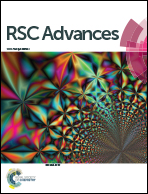Amphiphilic drug–drug assembly via dual-responsive linkages for small-molecule anticancer drug delivery†
Abstract
A newly designed drug–drug assembly prodrug for tumor therapy is reported. Hydrophilic irinotecan (Ir) and hydrophobic doxorubicin (DOX) were assembled into amphiphilic micelles via specific H-bond-instructing double disulfide bonding that is pH- and redox-responsive. The micelles aggregated to form water-dispersible Ir–DOX small molecule assembly (SMA) nanoparticles with an average diameter of 68.7 nm. The Ir–DOX SMA nanoparticles can release Ir and DOX simultaneously under conditions characteristic of the environment in cancer cells. Decomposition of the Ir–DOX SMA nanoparticles which gives rise to the drug release can be monitored in real time based on fluorescence resonance energy transfer (FRET) between the Ir and DOX moieties. In vitro cell experiments indicate that the Ir–DOX SMA nanoparticles are able to kill cancer cells efficiently with reduced multiple drug resistance (MDR) effect. Compared with the drug formulations such as Ir, DOX and Ir/DOX mixture, the drugs released from the Ir–DOX SMA nanoparticles can escape rapidly from the intracellular endolysosomal system and reach the nucleus, bypassing the drug efflux pump. This work provides a new concept of preparing drug delivery vehicles that may be applied in cancer chemotherapy.


 Please wait while we load your content...
Please wait while we load your content...